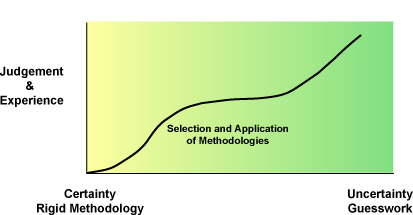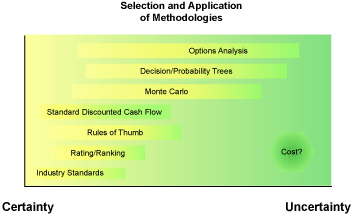Valuation Methodologies
All valuations are based in part on one of the following traditional approaches:
In evaluation methodologies, the following criteria must be considered:
Patents and technology
Trademarks and brands
Copyrights
Assembled workforce
management Information Software
Product Software
Distribution Networks
Franchise Rights
Corporate Practices and Procedures
Income
Income
Income
Cost
Cost
Income
Cost
Income
Cost
Market
Market
Market
Income
Market
Market
Income
Market
Income
Cost
Cost
Cost
Market
Income
Cost
Market
Cost
Market
Valuation Approaches Incorporating Uncertainty
In an ideal world, there would be only one method of valuation leading to one answer independent of the valuer. however, by its very nature, valuation must deal with uncertainty associated with varying market perceptions, differing value propositions, different perceptions of time and money and differing perspectives of risk. As a result, there is a range of alternative approaches to valuation available depending on the degree of uncertinty associated with the asset being valued and as the degree of uncertinty increases, the judgement and experience of the valuer becomes paramount not only in the selection of the most appropriate approach, but also in how the methodology is applied.
The most commonly recognised valuation techniques include (1) Industry Standards, (2) Rating/Ranking, (3) Rule of Thumb, (4) Standard Discounted Cash Flow plus probability adjusted and risk adjusted discounting, (5) Monte Carlo Approach, (6) Probability and Decision Tree Approaches and (7) Options analysis. All of these approaches require critical analysis, but as the degree of uncertainty increases, the valuer is increasingly required to adopt some subjectivity based on experience to arrive at a valuation result. A brief description of each of the above methods is provided below.
The diagram below indicates the usefulness or applicability of these methods as uncertainty increases.

The Industry Standard approach relies heavily on similarities - the existence of a market history such as a large available database of similar transactions which can be used as comparison to infer value on the basis of likenesses. As a result, this approach is usually used for the valuation of mature and commonplace technologies or other intangible assets where there is no or very limited uncertainty about applications of the asset.
The Rating/Ranking approach relies on contrast in which the subject asset is distinguished from reference assets or arrangements to identify differences. These differences can then be appraised through the application of scoring criteria and the resulting scoring scale and associated wighting factors can be used to construct a decision table which enables the generation of a valuation range. This method can be used with the Industry Standard Method with the result from one method providing a reality check on the result from the other method.
The Rule of Thumb approach has been used for some time because of its simplicity, convenience and ease of use in non-litigation settings for example in licensing arrangements. The approach is also known as the 25% rule or the 25-33% rule and is based on practical experience that a quarter to a third of the total value created by or from a deal or earnings before interest and tax which the buyer or licensee of the asset realises with the lesser amount going to the licence fee or royalty. This approach should aways be viewed as an approximation or guide and, as a result, development or investment required or due to the degree of risk, the opportunity for exception increases and the less suitable the Rule of Thumb approach becomes.
The Discounted Cash Flow approach has come out of financial policy and management practice and is based around the formula PV=FV(a+k)t, where PV is the present value of money, FY is the future value of miney, k is therate of return and t is the time period for which an investment lasts. This method is a means of converting future cash flows into a present day equivalent. The very basis of this method is uncertainty: uncertainty about future cash flows, about the selection of a suitable discount rate or rate of return and uncertainty about the period over which future cash flows take place.





